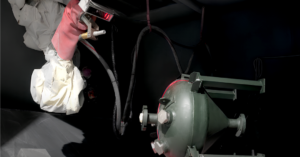table of contents
- Heading 1
- Heading 1
- Heading 1
share this
In the fast-paced landscape of technological advancements, robots are not just a novelty but a critical component driving efficiency, productivity, and safety across industries. As we step into 2024, several sectors stand out as pioneers in robotic innovation, reshaping the future of work. From industrial automation to AI integration and high deposition welding, let’s explore the top robot industries to watch this year and the transformative impact they’re making, along with a glimpse into other industries benefiting from robotic advancements.
Industrial Automation
Industrial automation, a cornerstone of robotic advancement, continues to revolutionize manufacturing and logistics. According to MarketsandMarkets, the industrial robotics market is valued at USD 17 billion in 2023 and is projected to reach USD 32.5 billion by 2028.
A key trend in 2024 is the rise of collaborative robots (cobots) designed to work alongside human counterparts. This shift towards human-robot collaboration enhances flexibility and safety in manufacturing environments. Additionally, the integration of Internet of Things (IoT) technologies and cloud computing is enabling real-time data analytics, predictive maintenance, and remote monitoring of robotic systems, optimizing operational performance.
AI and Robotics Integration
The convergence of artificial intelligence and robotics is a driving force behind the transformation of industries. According to MarketsandMarkets, the global AI in robotics market is projected to reach $35.3 billion by 2026, with a compound annual growth rate (CAGR) of 38.6% from 2021 to 2026.
In automotive manufacturing, AI-powered robots equipped with advanced vision systems and machine learning algorithms enhance quality control processes, detect defects, and optimize production workflows. This integration improves product quality and reduces downtime and operational costs. Predictive maintenance algorithms, powered by AI, enable proactive identification of potential equipment failures, minimizing unplanned downtime and optimizing asset utilization.
General Industry
General industries, including construction, retail, and logistics, are undergoing a robotic revolution to boost productivity and operational efficiency. According to Research and Markets, the global construction robotics market is anticipated to grow at a CAGR of 16.5% from 2022 to 2030.
In the retail sector, e-commerce giants like Amazon are deploying warehouse robots to streamline order fulfillment processes, reduce labor costs, and improve customer service. Robotic fulfillment centers not only ensure faster order processing and shipment but also meet the escalating demand for e-commerce services.
High Deposition Welding
High deposition welding, crucial for industries such as aerospace and shipbuilding, is experiencing a transformation with robotic integration. Research and Markets project that the global welding robots market will reach from US$ 1,240.18 million in 2022 to US$ 1,919.62 million by 2028. It is estimated to grow at a CAGR of 7.6% from 2022 to 2028.
Robotic welding systems equipped with laser and arc welding technologies offer advantages like higher precision, faster production rates, and reduced material waste. These systems enable manufacturers to achieve superior weld quality, tighter tolerances, and greater productivity, ultimately enhancing competitiveness in high-demand industries.
Other Industries to Watch in 2024
Agriculture: Robotics is revolutionizing farming practices, from precision planting and harvesting to autonomous weeding and monitoring, enhancing yields and sustainability.
Food Service: Automation in kitchens and restaurants through robots is on the rise, automating cooking processes, food preparation, and delivery to meet evolving consumer preferences and enhance operational efficiency.
Healthcare: Robotics is transforming patient care and medical procedures, with applications ranging from surgical robots for minimally invasive interventions to telepresence robots for remote consultations and monitoring, improving outcomes and accessibility.
Logistics/Inspection: In logistics, robots are reshaping supply chains and quality control processes. Automated drones and robotic arms streamline inventory management, package handling, and facility inspections, ensuring reliability and compliance in dynamic environments.
Conclusion
In summary, the top robot industries to watch in 2024 are at the forefront of a technological revolution, reshaping the future of work across diverse sectors. Backed by robust statistics and propelled by relentless innovation, these industries are not merely adapting to change but driving it. As we witness the continued evolution of technology, the synergy between humans and machines promises a future characterized by unparalleled productivity, efficiency, and progress. The transformative power of robotics is not just a glimpse into the future; it is the fabric of the industrial landscape we inhabit today.
Header Image Source




